Growing tomatoes at home is an absolute must for most gardeners. In this post, I’ll show you everything you need to know in order to have the biggest and best yields.
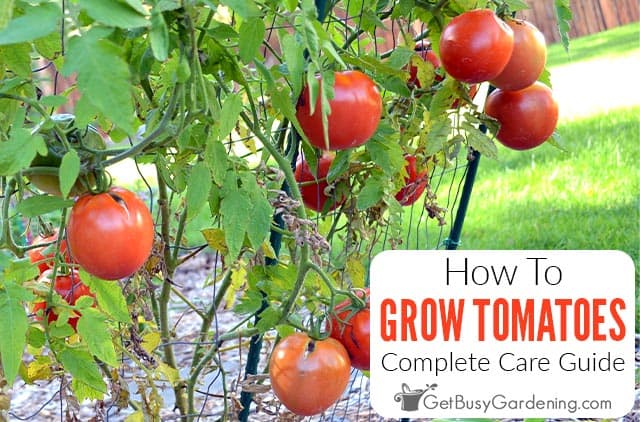
As one of the most popular veggies around, it’s not surprising that so many people want to grow their own tomatoes.
The good news is that even a beginner can learn how to do it easily, even if they don’t have a garden patch, or even a backyard.
Below you’ll find all you need in order to be successful. From getting them in the ground to caring for tomato plants all the way through the end of the growing season.
Tomatoes Quick Care Overview
| Scientific name: | Solanum lycopersicum |
| Classification: | Vegetable |
| Common names: | Tomato |
| Hardiness: | Annual |
| Temperature: | 55-85°F |
| Flowers: | Yellow, blooms summer-frost |
| Light: | Full sun |
| Water: | Keep evenly moist, do not overwater |
| Humidity: | Average |
| Fertilizer: | High phosphorus fertilizer spring-summer |
| Soil: | Rich, fertile, well-draining |
| Common pests: | Aphids, thrips, whiteflies, hornworms |
Information About Growing Tomatoes
Tomatoes are a part of the nightshade, or Solanacae family of plants. This also includes peppers, tomatillos, eggplant, and potatoes.
They’re a warm weather annual that’s native to South America, but is now grown all over the world.
The sizes can range anywhere from compact bushes to towering 10’ plants that are made up of leafy green foliage and vining stalks.
Different Kinds Of Tomato Plants
There are way too many varieties to list in one place (try thousands!). But in general there are two main types of tomatoes you can grow.
Determinates are the smaller bush varieties that are ideal for containers. While indeterminates are the larger vining types that can become huge. Learn more about the difference between the two here.
Both can yield delicious fruits, and you can find cherry, slicing, or paste in heirlooms or hybrids for each.
Some of the most popular ones among home gardeners are Early Girl, Beefsteak, Better Boy, Roma, Supersweet 100, Cherokee Purple, Amish Paste, and Brandywine.
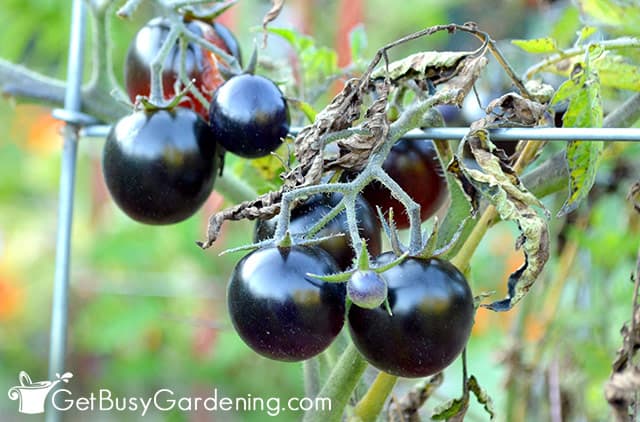
How Do Tomatoes Grow?
Like many other veggies, tomatoes grow from the pollinated flowers. Each blossom contains both the male and female parts needed to set fruit.
Wind, bees, or our intervention all help to make sure the pollen is spread around as needed.
The fruits will start out tiny and green, and eventually swell to their full size while slowly changing in color.
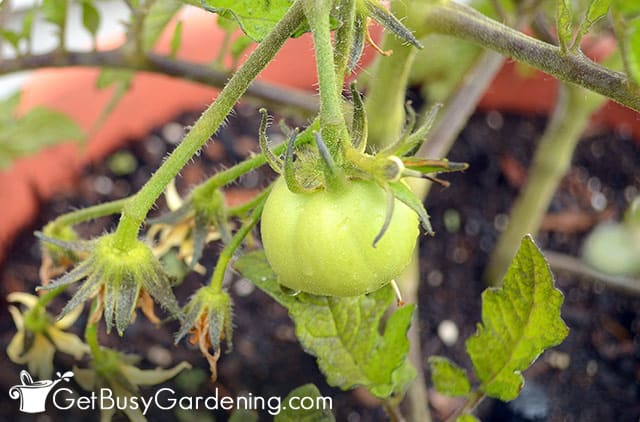
How Long Do Tomato Plants Live?
For most of us, tomato plants will only live for one growing season. They are annuals, so they can technically live for about one year in ideal conditions.
How Long Do Tomato Plants Produce?
The length of time that tomato plants produce really depends on the variety, environment, and your climate. Warmer areas can enjoy them for longer than cooler regions.
Small fluctuations, like temps above 90°F or below 50°F will affect how well they can set fruit too.
Pests, disease, and lack of water or nutrients can also be a factor.
It also depends on the type. In ideal conditions, many will produce fruit continually for several months. But some only yield a single crop over the course of a few weeks.
How To Grow Tomatoes
Choosing the right location with plenty of space and light is essential to growing healthy tomato plants. Let’s talk about how to find the perfect spot.
Where To Grow Tomato Plants
Choosing the right location begins with your variety. Determinate types are ideal for containers.
While indeterminates are much too large, and need a garden bed where they have plenty of room to spread out.
Either way, tomatoes need rich, fertile soil, and between 6-8 hours of direct sun to grow and produce at their best.
Related Post: How To Grow Tomatoes In Pots
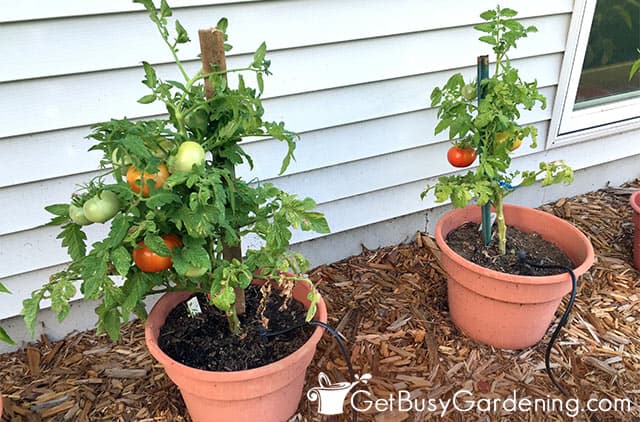
Tips For Planting Tomatoes
At planting time it’s a good idea to start the seeds indoors so you can transplant healthy starts as soon as the weather warms, and maximize your season. Warmer climates can sow them directly in early spring.
When transplanting, tomatoes are unique. They’ll grow roots from any part of the stem, so it’s best to nestle them deeply, right up to the bottom of the first set of true leaves.
This will give them a strong, sturdy base, with an ample root system for absorbing the maximum amount of nutrients and moisture.
They also need lots of space, so give them 2-3’ between each plant, and keep rows no closer than 4’ apart.
Tomato Plant Care & Growing Instructions
Once you understand how to care for them, growing tomatoes isn’t difficult. In this section you’ll find detailed tips for how to keep them thriving.
Sunlight
Tomatoes grow best in a full sun location. Ideally, provide them with 6-8 hours of direct sunlight every day.
Certain types of small varieties may tolerate partial shade, but they will produce much better in full exposure.
If you live somewhere with sweltering summers, protect them during the hottest part of the day with row covers or shade cloth.
Water
Tomatoes are thirsty plants, but don’t like wet feet. They’ll need about 1-2” of rainfall or irrigation every week. A moisture probe will help you get it just right.
Keep them evenly moist by deep watering every few days, or when the top few inches feel dry. In hot weather check more frequently so they never dry out completely.
Take care to water them at the base to keep the leaves dry, and avoid splashing soil on them. This will help to prevent fungus and disease issues.
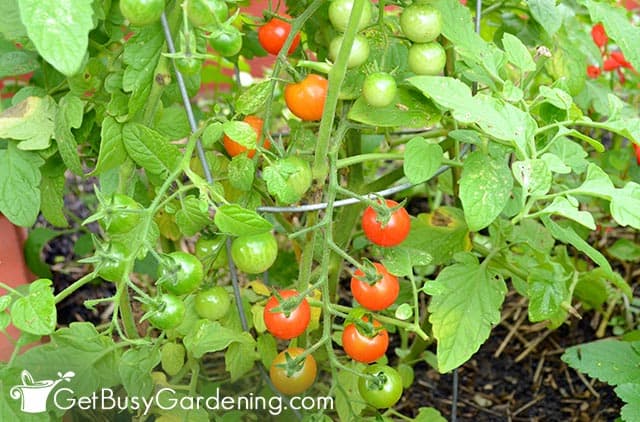
Temperature
The ideal temperature range for growing tomatoes is between 55-85°F. They won’t set fruit and can begin to suffer if it gets much lower.
During heat waves, temps higher than 90°F during the day or 75°F at night can cause blossom drop, and prevent the fruits from ripening. Providing temporary shade or mulching the soil can help them cope.
Fertilizer
Begin feeding your tomatoes with a balanced organic fertilizer as soon as they start growing. Add slow-release granules to the hole during planting, or water with compost tea or fish fertilizer afterwards.
Once they begin flowering, switch to a phosphorus heavy blend. Use liquid formulas once every 1-2 weeks, or top dress with granules once a month.
Soil
Tomatoes need rich, well-draining, fertile soil with a pH between 6 – 6.8. Test it with a pH probe before planting, and amend acidic soils with garden lime as needed.
For poor quality soils, work in compost at the beginning of the season to improve fertility and drainage.
Caging & Trellising
All tomato plants will need support at some point during the season, even the smaller bush types. Add a cage, stake, or trellis at planting time, rather than waiting, to avoid root damage.
A stake is easier to install and takes up less space, but will require more maintenance.
Basic wire cages will work for smaller varieties, but larger plants will need a sturdier one or a trellis when they get very large.
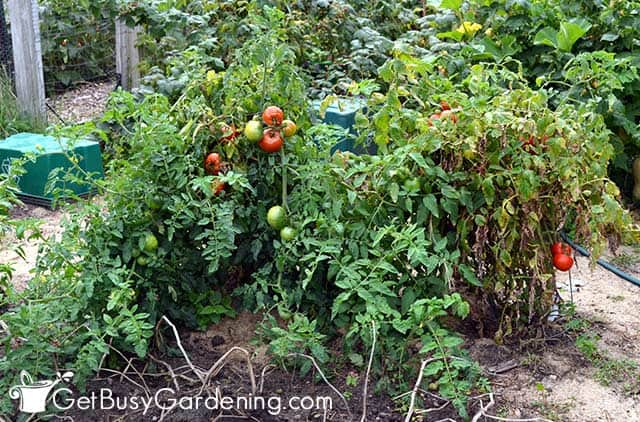
Pruning
If your tomato plants are growing and producing at a rate you’re happy with, there’s no need to prune them. However poor producers can be encouraged to fruit more by giving them a trim.
Pinch any suckers that form between the main and side stems. You can also clean up the bottom 6-10” of the plant, which will help prevent soil borne diseases, and improve airflow.
Related Post: Quick & Easy Pickled Green Tomatoes Recipe
Pest Control Tips
There are a variety of pests that love tomatoes as much as we do. Aphids, thrips, whiteflies, and hornworms are just a few of the more common ones.
Small insects can be treated with insecticidal soap, a neem oil spray, or blasted off with a sharp stream of water. Larger ones are best controlled by daily monitoring and hand picking.
Squirrels are another common pest, and they like to take a bite out of the juicy fruits during the hot summer months.
It’s best to protect the entire plant with chicken wire, but you could also try wrapping each fruit loosely with tulle fabric.
Disease Control Tips
Unfortunately there are a wide variety of diseases you may have to deal with when growing tomatoes. But there are steps you can take to keep your plants healthy.
- Blossom end rot – Calcium deficiencies can cause the bottom of the fruits to rot on the vine. Inconsistent watering, root damage, or depleted nutrients can all play a role. Test the soil and amend if needed, and make sure you’re watering properly.
- Late or early blight/bacterial wilt – These fungal diseases can cause black, brown, or yellow spots on the leaves, fruits, and stems, and eventually leaf drop. Prevent them by watering at the base instead of overhead, giving the plants good air circulation, and practicing crop rotation.
- Powdery mildew – This airborne mildew appears as white spots on the leaves. It can be managed by removing affected foliage and destroying it. Keep plants adequately spaced to promote good air circulation. An organic fungicide can help control it early on.
Related Post: How To Make Sun Dried Cherry Tomatoes
Tips For Harvesting Tomatoes
Color and size are the best ways to know when harvest time is near. The bottoms will begin to darken to their mature hue first.
As soon as the change appears, you can technically pick them. But it’s best to wait until they’re firm but soft, and deeply colored for the best flavor.
Some will twist off the vine easily. But to avoid damaging the plant or the fruit, I recommend using a sharp pair of snips to cut them free. Learn exactly when and how to harvest them here.

Troubleshooting Common Tomato Growing Problems
Growing tomatoes can come with some challenges. Below I’ve listed some of the most common issues, along with tips to help you get them back on track.
Tomatoes Splitting
When tomatoes crack or split on the vine it’s because of inconsistent watering. This can happen at any time, but it’s most common after a rainfall.
That’s because the fruits on dehydrated plants swell faster than the skin can grow, and it pops them open.
It’s very important to give them consistent, even moisture. Rather than giving them frequent small drinks, water deeply a few times a week.
Related Post: How To Can Cherry Tomatoes
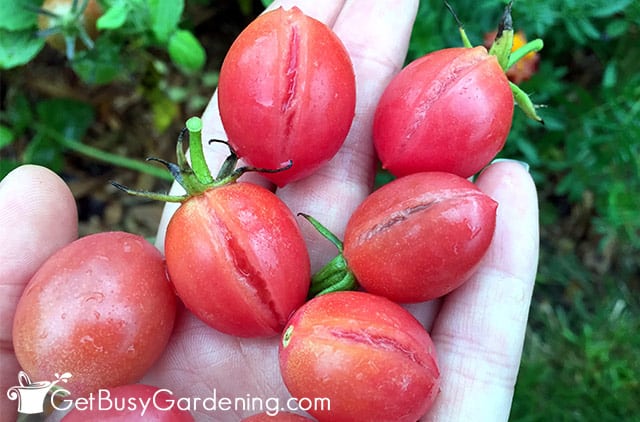
Bottoms Of Fruits Rotting / Blossom End Rot
Blossom end rot is due to a calcium deficiency that can be caused by root damage, water stress, or lack of nutrients.
The best way to avoid this is to always keep the soil evenly moist without saturating it, avoid cultivating near the roots, and fertilize regularly.
Overgrown Tomato Plants
Large tomato plants can quickly become overgrown and out of control when they’re in a good environment.
To manage the size, be consistent with pruning and staking, and remove a few branches that aren’t bearing fruit.
No Flowers
Lack of flowers is usually caused by low phosphorus in the soil. Too much nitrogen will cause tons of green foliage growth, but not blossoms.
Switch to using a higher phosphorus fertilizer to stimulate flower formation and healthy fruit production.
Lots Of Flowers, But No Fruit
There are a few reasons your tomatoes have lots of flowers but no fruit. Extreme heat or cold can cause them to drop off or die. Otherwise, the flowers aren’t being pollinated.
You can hand pollinate with a cotton swab by running it around the interior of each flower, or try to attract more bees to the garden to help you out.
Tomatoes Aren’t Ripening
There are a few reasons why they won’t ripen, and several steps you can take to help them out. You can learn all about it in this guide.
But in short, pinch off all new growth including flowers and suckers and remove some leaves. That will focus the plants energy on ripening what’s there, instead of producing more leaves and flowers.

FAQs About Growing Tomatoes
Here I’ve answered some of the most commonly asked questions about how to grow tomatoes. If yours isn’t on this list, please ask it in the comments section below.
How long does it take tomatoes to grow?
How long it takes tomatoes to grow varies depending on the specific varieties. Temperature, sunlight, and their care will all affect it too. But in general, most will be ready sometime between 60-100 days after germination.
What is the secret to growing tomatoes?
The secret to growing tomatoes is to give them all the things they love. Warm temperatures, plenty of sunlight, well draining fertile soil, deep drinks of water on a consistent basis, and regular feedings.
When do tomato plants stop producing?
Most tomato plants stop producing when the weather cools in the fall. Some varieties only produce a single crop, and will decline shortly after they’ve finished fruiting. Others will stop once they reach the end of their natural life cycle, which is about one year.
What makes tomato plants grow best?
Tomato plants will grow best in rich, fertile soil with regular feedings of organic fertilizer, plenty of water, and lots of sunshine.
What helps tomato plants grow faster?
The best way to help tomato plants grow faster is to give them the best care and environment that you can. They need lots of sunshine, warmth, nutrients, and consistent moisture.
Do tomato plants need sun all day?
Tomato plants prefer to have full sun all day, between 6-8 hours for best production. However, intense heat can affect fruiting, so they may require afternoon shade during the hottest months in warmer climates.
Growing tomatoes doesn’t have to be scary or hard, it can actually be fun and exciting! With the care tips in this guide, you’ll be ready to tackle any problems that come your way, and watch the plants thrive in your garden.
If you want to learn all there is to know about growing up rather than out, my book Vertical Vegetables is exactly what you need. Plus you’ll get 23 projects that you can build in your own garden. Order your copy today!
Learn more about my Vertical Vegetables book here.
More About Vegetable Gardening
- How To Grow Cucamelons (Mouse Melon) At Home
- How To Grow Brussels Sprouts In Your Garden
- How To Grow Blueberries In Pots Or The Garden
- How To Grow Onions At Home
- How To Grow Green Beans At Home
Share your tips for how to grow tomatoes in the comments section below.
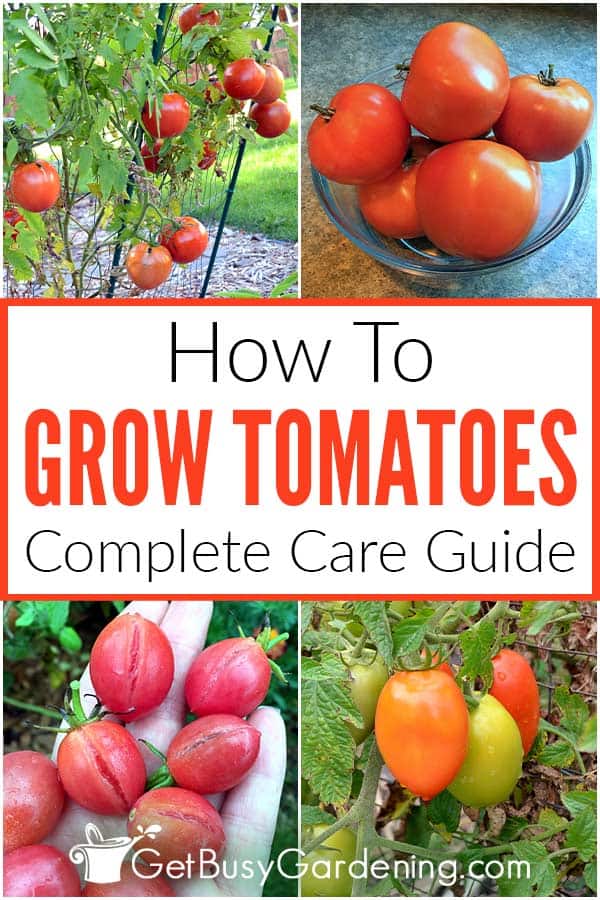

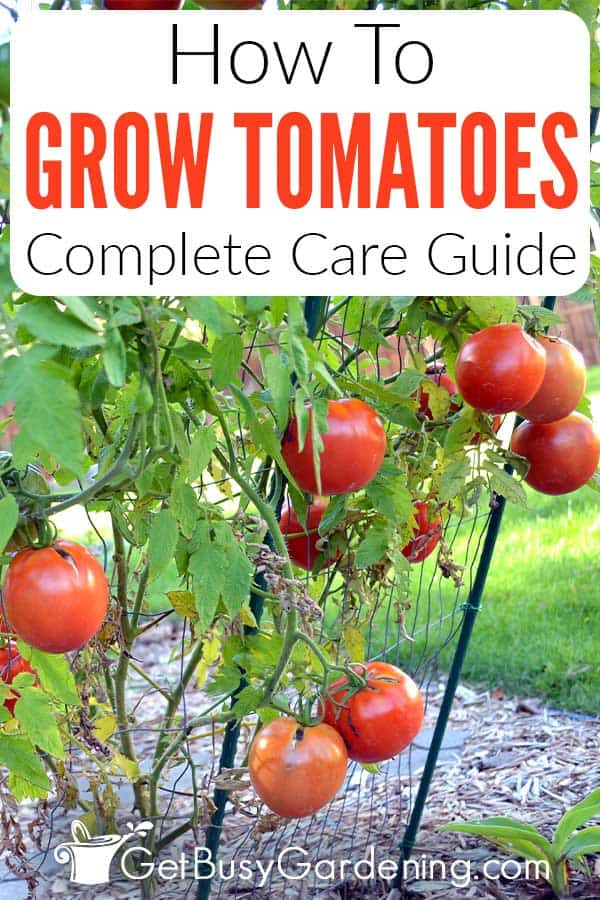



Paul Adamo says
Hi, I live in “HOT” Florida and I would really appreciate any books you have on growing tomatoes. I’m not too lucky getting them to full health and growth because of the extreme hot summer months. Thank you
Amy Andrychowicz says
Have you ever tried growing your tomatoes in the fall or winter, since it’s so hot in the summer where you live?
Hadili Goenawan says
We have try to plant the Tomatoes in the garden ,but the result no so happy .
We will try the guidance that you informs .
Many thanks for your sharing
Regards
Hadili
Amy Andrychowicz says
You’re welcome, and good luck with growing your tomatoes!